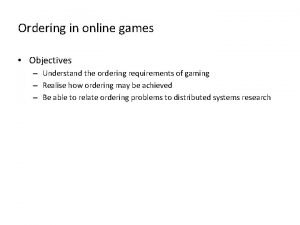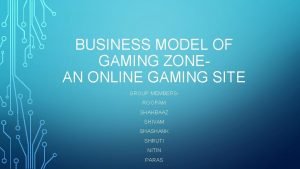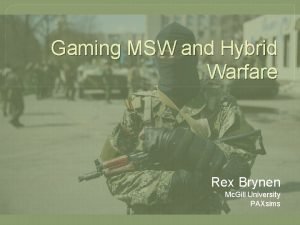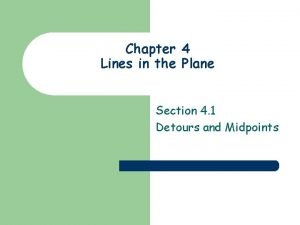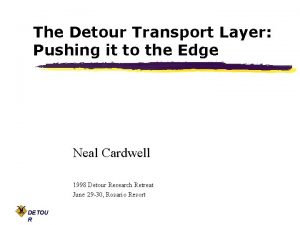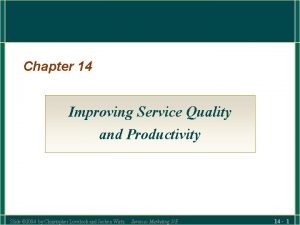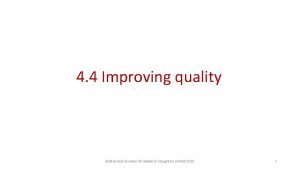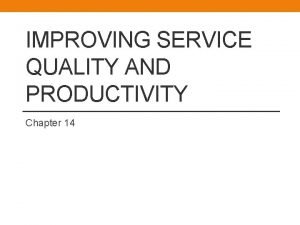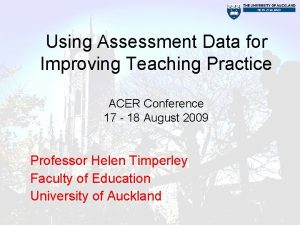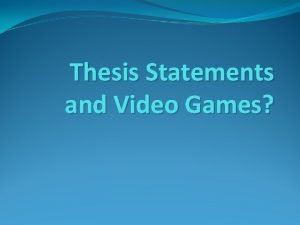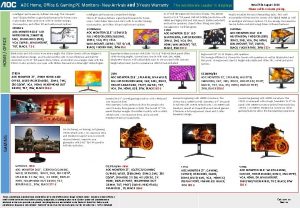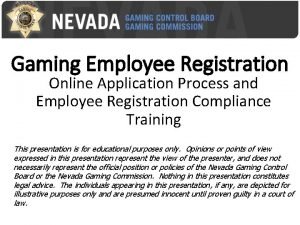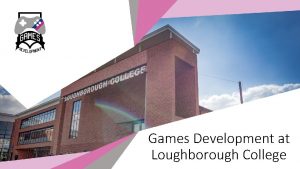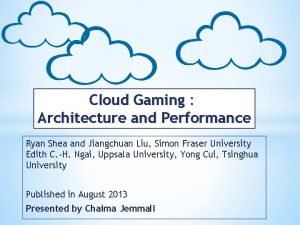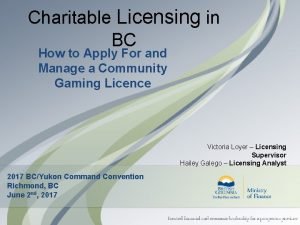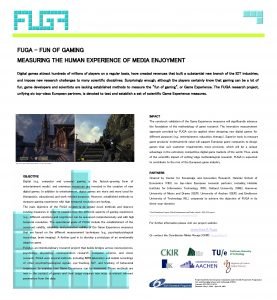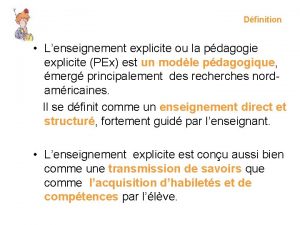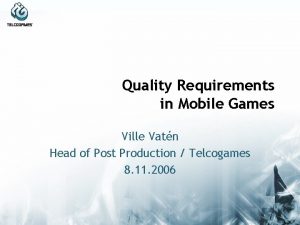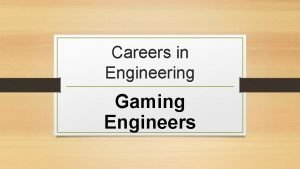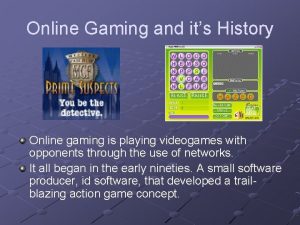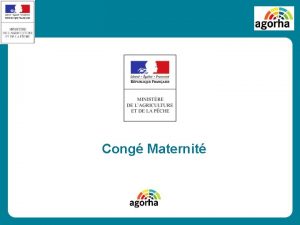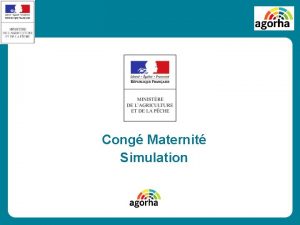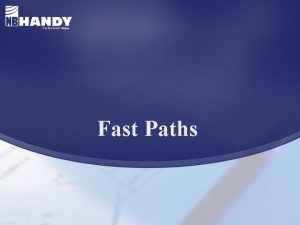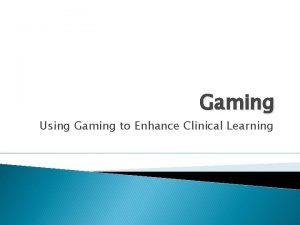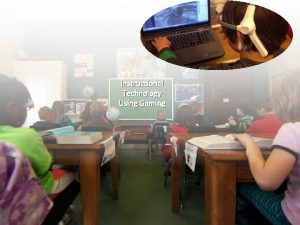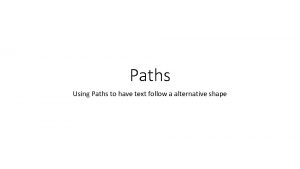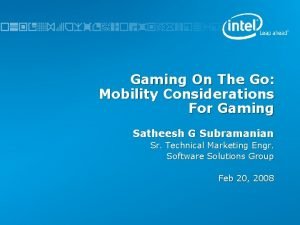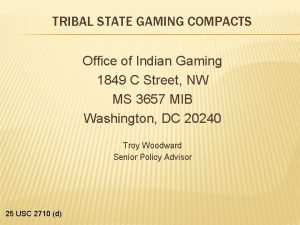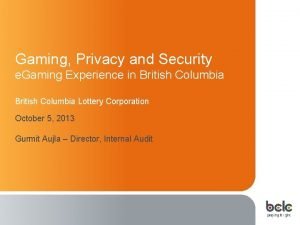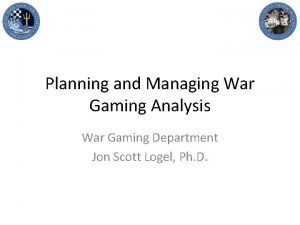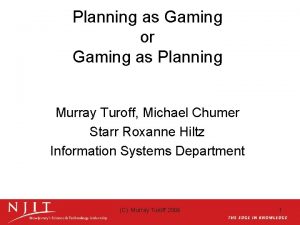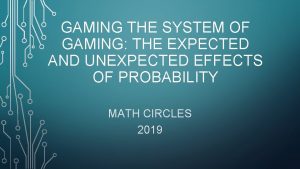Improving Online Gaming Quality using Detour Paths Cong

































- Slides: 33

Improving Online Gaming Quality using Detour Paths Cong Ly, Cheng-Hsin Hsu, and Mohamed Hefeeda Simon Fraser University, Canada Deutsche Telekom Labs, USA

Online Multiplayer Games § 37% of the US population played online games in 2009 [Nielsen] § World of Warcraft (Wo. W) has 11. 5 million subscribers [Blizzard] § Market research forecasts [NPD] - $48. 9 billion revenue by 2011 2

Online Gaming over the Internet § Gaming traffic - Highly periodic Low bit rates (25 – 100 bytes/packet) [Feng] Less sensitive to bandwidth and packet loss Sensitive to high latency § Network latency in the Internet - Geographical locations - Link congestion (failure) - Types of network technology, e. g. , 3 G data networks 3

Network Latency Game Type Avatar Omnipresent Example Genre Latency Threshold First-person shooter (FPS), Racing 100 msec Sports, Role-playing games (RPG) 500 msec Real-time strategy (RTS), Simulations 1, 000 msec § Different types of games can tolerate different amount of quality degradation caused by network latency [Claypool] § Higher than these thresholds would lead to significant drops in gaming quality § Players will leave the game More efficient routing is needed for game traffic! 4

Outline § Motivation § Problem Statement § Related Work § Design and Implementation § Real Deployments and Experimental Results § Simulation Results § Conclusions 5

Problem Statement § Players form game sessions § Problem: design an efficient system to reduce the network latency among players in each game session 6

Related Work § Latency compensation mechanisms - Lockstep and event-locking, controls consistency [Baughman ‘ 01] - Dead reckoning (DR), extrapolate the behavior [Bernierr ‘ 01] - Matchmaking, prevents high latency peers from playing together [Agarwal ‘ 09] - Hide network latency § Detour routing for latency reduction - RON (resilient overlay network) [Andersen ‘ 01] - Over. Qo. S uses overlay routing for Qo. S enhancements [Subramanian ‘ 04] - Peer. Wise searches for faster detour paths [Lumezanu ’ 07] - Not for online multiplayer games § We use detour paths in online gaming networks to directly reduce end-to-end network latency 7

Detour Paths § Detour paths: indirect paths that lead to smaller RTTs § Exist because of triangle inequality violations (TIVs) in Internet [Savage 99’] § Inter-domain policy routing § By routing game-state updates over detour paths, we can reduce end-to-end RTTs § How many hops should we consider when identifying detour paths? 8

Number of Hops § We conducted RTT measurements among more than 28, 000 IPs from online game players § We quantify the potential of detour routing in online games § Average RTT of detour paths § Reduced from 156 msec to 53 msec with just 1 -hop § Optimal k*-hop is 46 msec 9

Indirect Relay System (IRS) § We propose the Indirect Relay System (IRS) to identify 1 -hop detour paths § Straightforward approach: construct a graph - May take prohibitively long time to measure RTTs § A better solution: evaluate the likelihood for a client r to be the best relay client based on estimation errors of network coordinates § Higher estimation error results in higher likelihood of detour paths [Lumezanu ’ 09] § Actual relay node evaluations are distributed to the clients 10

IRS Server Design § Integration § Lobby server or Standalone § Shortest RTT (SRTT) Algorithm § Compute estimate errors § Select K potential relay clients 11

IRS Client Design § Integration § Game client § Shortest RTT (SRTT) Algorithm § Conduct actual RTT measurements to the K potential relay clients 12

Implementation § About 3, 700 lines of Java code. § Client & Server components § Network coordinates system § Uses Vivaldi, a decentralized network coordinate system § Based on open source Pyxida project [Ledlie] § Simulate real gaming traffic § Randomly send packets between 25 -100 bytes § Relay overhead are embedded in the Proxy-Ping 13

Planetlab Deployment § On 500+ nodes § K potential relay clients and N neighbors are set to 32 § More than 3, 000 game sessions with length between 3 and 10 mins § Five experiments to rule out the time-of-day variations § 9+ hours each run § Results from the experiments are consistent, and we report the results from the experiment conducted on Jan 07, 2010 14

RTT Reduction § Some sessions are reduced from > 3 sec to < 0. 3 sec § More than 60% player pairs achieve more than 100 msec reduction 15

Gaming Performance Improvement § Better Qo. E better gaming performance § 30% of players can increase their hit fractions by more than 10% 16

Existence of Backup Detour Paths § Number of detour paths found by IRS § 55% of the clients have at least one detour path § 24% of the clients have two or more 17

Network Overhead § Server: up to 307 updates per minute for 500+ nodes § Client: sends one packet every 16 sec 18

Residential Deployment § Home computers with DSL and cable modem access links § 17 nodes, 7 cities around the world § Experiment ran for 1 week § K potential relay clients and N neighbors are set to 8 § Users are allowed to join and leave the experiment at any time 19

Latency Reduction § Despite with only 17 nodes, IRS identified 8 detour paths § 50% reduction for Vancouver to Linkoping (199 msec to 101 msec) § A backup detour path through another Vancouver node leads to 162 msec 20

Simulation Setups § Evaluate the IRS system with wider ranges of parameters - Results are in the papers § Study the matchability improvement of different RTT threshold - Compute the number of other players each player can connect to while maintaining acceptable gaming quality - Calculate the difference with and without the ISR system 21

Matchability Improvement § With a 100 msec threshold, more than half of the player can connect to 20% more players with the ISR system 22

Conclusions § We proposed to reduce latency by leveraging on detour paths § We designed and implemented IRS system to locate detour paths § We deployed this actual implementation on Planet. Lab and home computers, and conducted experiments § We used simulations to exercise the IRS system with wider ranges of parameters § Evaluation results indicate that our system - (i) reduces RTT, (ii) increases matchability, (iii) incurs low network overhead, and (iv) improves gaming quality (performance) 23

Questions and Comments Thank you! 24

Embedding Errors § Identifying TIV - Network coordinates are in Euclidian space - Calculated as “Estimates – Measured” - +40 and +30 indicate “excess” estimates. -30 under estimated 25

Likelihood Function if D(s, r) is known; if D(r, t) is known; if D(s, r) and D(r, t) are known 26

Measuring Relay Overhead § Relay Overhead - Commodity PC with 2. 8 Ghz Intel CPU - 6. 2 msec with Starcraft 2, real-time strategy game - 6. 5 msec with Counter Strike: Source, first-person shooter 27

Expected Impact Latency (msec) Hit Ratio Kill Count Death Count 50 49% 41. 00 10. 75 75 54% 39. 75 14. 00 100 42% 38. 25 16. 25 200 29% 35. 75 16. 75 250 29% 27. 75 17 300 19% § First-person shooter game - Significant drop in hit ratio when latency is greater than 200 msec. 28

Market Demand Potential § 37% of the US population played online games in 2009 [Nielsen] § World of Warcraft (Wo. W) have 11. 5 million subscribers [Blizzard] § 5 million players for the Halo franchise [Microsoft] § Market research forecasts [NPD] - $48. 9 billion revenue by 2011 § Internet gaming traffic forecasts [Cisco] - 239 PB/month world wide by 2013! 29

Thesis Contributions § Using RTT measurements, we quantify the potential of detour routing in online multiplayer games. § We analyze the expected impact of 1, 2, 3 and k*-hop detour routing on player performance in different online games. § We propose a 1 -hop overlay routing system called Indirect Relay System (IRS). § Using results from Planetlab and residential deployments we show that IRS reduces RTT (roundtrip time) among players in online games. 30

Measurements Study § We conducted measurements study § RTT measurements from more than 28, 000 IPs from online game players. § 18. 8 million pair-wise RTT measurements § We quantify the potential of detour routing in online games. § Impact of detour routing in online games § Potential of 1, 2, 3, and k* relay clients 31

Average RTT § Reduced from 156 msec to 53 msec with just 1 -hop § Optimal k*-hop is 46 msec. 32

Impact On Actual Games § Hit Ratio improvements § 60% of players gain at least 10% just 1 -hop 33
 Indiana gaming commission charity gaming division
Indiana gaming commission charity gaming division Objectives of online gaming
Objectives of online gaming Online gaming business plan
Online gaming business plan Msw games
Msw games Detour ddo
Detour ddo Detour proofs
Detour proofs Java detour menu
Java detour menu Detour transport
Detour transport Improving service quality and productivity
Improving service quality and productivity Benefits and difficulties of improving quality
Benefits and difficulties of improving quality The listening gap
The listening gap Gaps model for improving service quality
Gaps model for improving service quality Using assessment data for improving teaching practice
Using assessment data for improving teaching practice Waptrice game
Waptrice game First generation consoles
First generation consoles Thesis statement game
Thesis statement game Swot games
Swot games Jo14 gaming twitter
Jo14 gaming twitter Christopher wiig
Christopher wiig Hp omen gaming accessories
Hp omen gaming accessories Gaming sitz homeoffice
Gaming sitz homeoffice Gcbger.nv.gov/regapp
Gcbger.nv.gov/regapp Dhruv gaming blogspot
Dhruv gaming blogspot Loughborough college gaming
Loughborough college gaming Cloud gaming architechture
Cloud gaming architechture Bc gaming account summary report
Bc gaming account summary report Gaming culture in the philippines
Gaming culture in the philippines North american gaming regulators association
North american gaming regulators association Serious gaming drama
Serious gaming drama Fuga gaming
Fuga gaming Master serious gaming
Master serious gaming Pédagogie explicite
Pédagogie explicite Gaming entertainment in hospitality industry
Gaming entertainment in hospitality industry Ville gaming genre
Ville gaming genre

